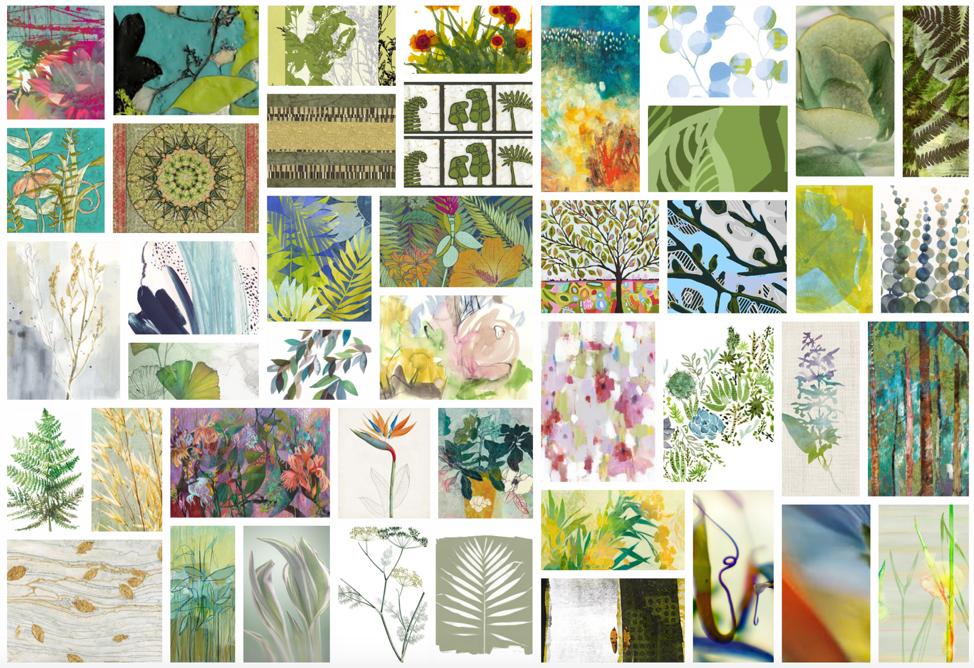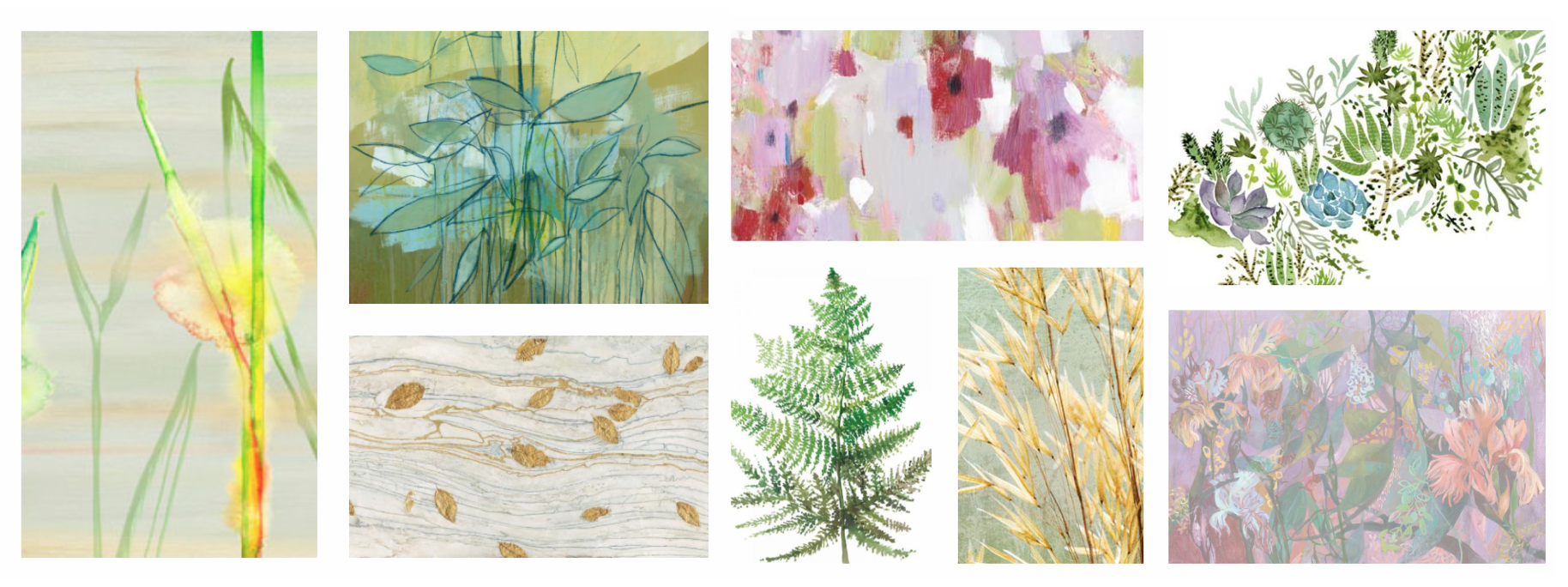Look Book Issue 3 | Be Well 20/20 | Mind Artwork and The Positive Effects on the Mind

ARTWORK & THE POSITIVE EFFECTS ON THE MIND
Studies have shown that artwork within the workplace increase levels of productivity and well-being. According to Scott Rice Vendor, Great American Art, “Artwork can support the creation of a positive connection by transforming a ‘space’ into a ‘place’.”
The selection of artwork for an organization’s spaces is sometimes an afterthought. The client or a designer may choose pieces based on how they complement a palette, or they prioritize their personal taste over the setting and its users. The relevance of artwork in places where it is not the main attraction can be more difficult to grasp beyond ‘a nice picture on the wall’. Yet, art doesn’t lose its significance in workaday places. A work of art in an everyday setting is also a product of history and culture, but attitudes about where art with a capital ‘A’ belongs relegates it to the realm of décor – implying that it’s less meaningful and important.
However, with recognition of the role the physical work environment plays in employee well-being, art is increasingly understood as an important part of creating aesthetically enhanced spaces that aim to increase employee satisfaction. The environment can have a wide range of effects on psychological and social processes, among which are job satisfaction, stress reduction, emotional well-being, and the performance of complex cognitive tasks. Studies on the effect of workplace environments on employees demonstrate that enriched environments, particularly those enhanced by art and plants, are more conducive to well-being and productivity, particularly if employees are able to have a degree of control over the appearance of the space. In contrast, aesthetically deprived environments are associated with greater passivity, withdrawal, and negative feelings about work. Enhancing the aesthetic quality of the environment can take many forms, among which is increasing visual interest and variety through artwork.
“Studies on the effect of workplace environments on employees demonstrate that enriched environments, particularly those enhanced by art and plants, are more conducive to well-being and productivity …. In contrast, aesthetically deprived environments are associated with greater passivity, withdrawal, and negative feelings about work.”
Where space and budget allow, purchasing or commissioning original artwork, such as sculptures, for public spaces is an excellent option. If the budget doesn’t allow for original work, large works of art can be reproduced economically for aesthetic impact; strategically placed as dominant and positive landmarks in dialogue with the surrounding space to enhance readability, wayfinding, and positive experience.
Artwork in public spaces, such as lobbies and entrances, can be in a variety of media and modes of representation, from realism to abstraction; and it can introduce and establish a cohesive theme that is carried throughout the facility. Marking a transition into a space, artwork can be welcoming and inclusive, communicating values, and identity in a symbolic or iconic way. It can also reinforce community engagement and relationships by featuring the work of local artists or images that create a bridge between the interior and familiar sights and associations from the surrounding environs.
Artwork can support the creation of a positive connection by transforming a ‘space’ into a ‘place’. Aesthetically, it can mark and fill a space, adding texture and providing sensory pleasure. It can communicate and inspire stories, promoting imaginative and emotional engagement that can nurture new forms of belonging. And while its selection can be informed solely by a decorative approach that emphasizes a specific color scheme or style, the consideration of characteristics such as community demographics (e.g., age, gender, ethnicity, education), market segment psychographics (e.g., values, attitudes, interests), and culture can lead to a richer, more versatile art design. In organizational environments, art can elicit emotional and physical responses, and facilitate engagement in behaviors and emotions that support wellness.
 Exposure to views of nature, and to a lesser degree, surrogate images of nature have also been shown to relieve stress and to promote restoration when attention and other personal resources become fatigued. In design approaches such as evidence-based design and biophilia, the emphasis on art depicting nature scenes is informed by health research that demonstrates that exposure to nature views can not only lower blood pressure but also lessen the length of hospital stays and the amount of pain medication taken by a patient. Here is a curated collection of nature art, as an example, that can help to inspire a selection of pieces.
Exposure to views of nature, and to a lesser degree, surrogate images of nature have also been shown to relieve stress and to promote restoration when attention and other personal resources become fatigued. In design approaches such as evidence-based design and biophilia, the emphasis on art depicting nature scenes is informed by health research that demonstrates that exposure to nature views can not only lower blood pressure but also lessen the length of hospital stays and the amount of pain medication taken by a patient. Here is a curated collection of nature art, as an example, that can help to inspire a selection of pieces.
Selecting images of nature that are pleasing to the eye is only one facet of incorporating this indirect experience of nature. Supporting positive human-nature relationships and reinforcing the connection between a community and its natural environs entails a greater consideration of the local or regional environment. While familiar nature scenes of the area are a great starting point, taking the time to research indigenous plants and animals offers opportunities to create richer and more creative visual encounters with nature. Further, the manner in which a work of art speaks to other aspects of the indirect experience of nature, like through materials, color, and naturalistic shapes and forms can inform its selection.
By: Great American Art
Image copyrights: All rights reserved to Great American Art, Kate Archie, Christopher Balder, Cheryl Baynes, Andrea Davis, Karen Fields, Catherine Kohnke, Getty Images, Caroline Gold, Jennifer Goldberger, Julia Hacker, Tang Ling, Alicia Ludwig, Kathy Mahan, Naomi McCavitt, Megan Meagher, Rebecca Meyers, Ricki Mountain, Nouroke, Tim O’Toole, Jennifer Paxton Parker, Thea Schrack, Piper Rhue, April Richardson, Carolyn Roth, June Erica Vess, Vision Studio, Melissa Wang, Eva Watts, James Wienes, Bonnie Wilkins, Valerie Wilson, Chariklia Zarris
